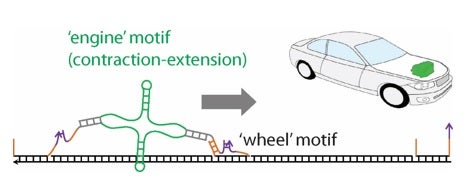The nanomotors are made of engineered DNA and operated by light free of any chemical waste. These re-usable nanomotors are particularly advantageous for applications requiring repeated or sustainable action, including remotely controlled precise manipulation, nanomotor-guided molecular assembly or synthesis, and nanomotor-mounted active delivery of drugs. Some of the applications had been demonstrated with un-reusable nanomotors, which will be drastically extended by the new motors.
Following the successful demonstration of this new generation of nanomotors, the scientists are continuing their research to improve the motors’ technical performance up to the requirements of real-world applications. These rationally designed, bioinspired nanomotors also offer rarely available model systems to study some subtle science pertinent to artificial nanomotors in general as well as their biological counterparts.
Particularly noteworthy is the discovery of a modular design principle by which a bipedal track-walking nanomotor may be constructed from simpler molecular ‘parts’ widely available from nanodevice research. Inventing nanomotors remains a difficult job doable by just a few labs over the globe, which is a sharp contrast to the widespread success of nanodevice research. This conspicuous gap is now reduced, likely leading to a dramatic expansion of the field of nanomotors.

Figure shows a bipedal nanomotor constructed from an ‘engine’ motif producing the driving force and ‘wheel’ motifs responsible for walking along a track–in a modular design reminding how a modern car is assembled from modularised parts. The nanomotor walks in a hand-over-hand gait under alternating visible light and ultraviolet light. Both the motor and the track are made of engineered DNA. [Image credit: Molecular Motors Lab at NUS Physics Department]
References
1. Cheng J, Sreelatha S, Hou R, Z Efremov, A Liu, R C, van der Maarel, J R, Wang ZS. “Bipedal nanowalker by pure physical mechanisms.” Phys. Rev. Lett. 109 (2012) 238104.http://physics.aps.org/synopsis-for/10.1103/PhysRevLett.109.238104)
2. Liu MH, Hou RZ, Cheng J, Loh IY, Sreelatha S, Tey JN, Wei J, Wang ZS. “Autonomous synergic control of a nanomotor.” ACS Nano 8 (2014) 1792.
3. Loh IY, Cheng J, Tee SR, Efremov A, Wang ZS. “From Bi-State Molecular Switches to Self-Directed Track-Walking Nanomotors.” ACS Nano 8 (2014) 10293.


